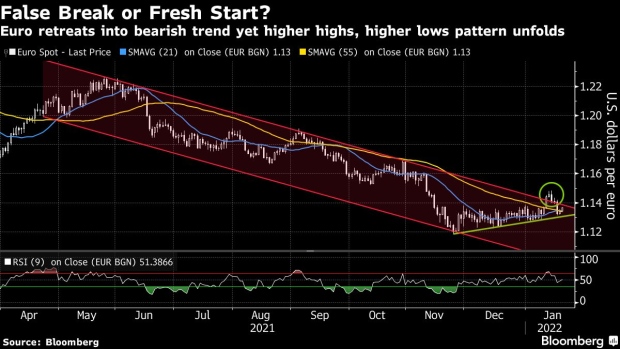Jan 20, 2022
A Euro Comeback Is Gathering Pace After Worst Year Since 2015
, Bloomberg News

(Bloomberg) --
The euro’s resilience in January, after delivering the worst annual loss in six years, may be just the beginning of a broader recovery as various indicators signal a more supportive backdrop for the currency.
The euro climbed to as high as $1.1483 last week, a level not seen since November, and traded at $1.1339 as of 6:41 a.m. in New York. While it has yet to breach key resistance at $1.15, technical gauges point to a more positive outlook.
The currency is also getting a boost from rate differentials this week, as German 10-year yields breach the zero threshold for the first time in more than two years.
This comes amid an intensifying stand-off between traders and the European Central Bank over the timing of interest-rate hikes. Despite insistence by officials that a hike is very unlikely in 2022, money markets now see a 10-basis-point increase to the deposit rate to minus 0.4% as early as September and an exit from sub-zero territory by the end of next year.
ECB Faces Stand-Off With Markets Over Rate-Hike Expectations
Here’s a look at some positive signs emerging for the euro:
Higher Highs
The common currency has been in a pattern of so-called ‘higher highs, higher lows’ since mid-December as momentum indicators point to upside risks. It briefly broke above a multi-month bearish trend channel last week and may do so again, with moving averages sending a bullish signal on Wednesday.
Rate Differentials
The euro has been showing resilience even as the gap between benchmark Treasury and German yields widened toward the most since March 2020. That comes as the dollar’s long-lasting relationship with rates broke down, with the greenback languishing near the lowest levels since November even as U.S. yields kept hitting multi-year highs.
Traders Rethink Fed Playbook as Dollar Breaks Link With Yields
There’s ample room for traders to ramp up bets on ECB rate hikes from about 18 basis points priced in for this year, relative to wagers of about 100 basis points of tightening from the Federal Reserve -- a process that would be supportive for further euro gains.
Burst of Energy
Traders’ bets on policy tightening could get a boost from surging energy prices. While ECB officials have stuck to the view of transitory inflation and noted that price pressures could recede this year, the International Energy Agency has said that oil markets look tighter than previously thought.
Meanwhile, food prices already near all-time peaks could rise further due to the growing appeal of turning more agricultural commodities into biofuels. Europe’s gas balance will remain unusually tight this year as curtailed supply, record-high gas prices, unprecedented volatility and geopolitical tensions show few signs of abating, according to BloombergNEF.
Hedging Risks
Risk reversals for the euro-dollar pair, a gauge of sentiment, show a premium for options to hedge against downside in the common currency across tenors ahead of the Fed’s Jan. 26 rate decision.
Further out, bearish bets are receding from extremes seen last year, particularly at the back end of the curve, likely due to potential risks related to the French election. Should markets price out that risk premium -- and should the ECB change its tune on rate hikes -- then a move toward bullish wagers could be due.
- NOTE: Vassilis Karamanis is an FX and rates strategist who writes for Bloomberg. The observations he makes are his own and are not intended as investment advice
©2022 Bloomberg L.P.


